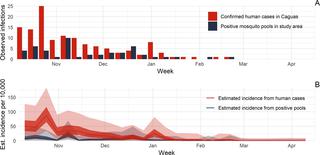当前位置:
X-MOL 学术
›
PLOS Negl. Trop. Dis.
›
论文详情
Our official English website, www.x-mol.net, welcomes your
feedback! (Note: you will need to create a separate account there.)
Comparing vector and human surveillance strategies to detect arbovirus transmission: A simulation study for Zika virus detection in Puerto Rico.
PLOS Neglected Tropical Diseases ( IF 3.4 ) Pub Date : 2019-12-26 , DOI: 10.1371/journal.pntd.0007988 Zachary J Madewell 1, 2 , Ryan R Hemme 3 , Laura Adams 3 , Roberto Barrera 3 , Stephen H Waterman 3 , Michael A Johansson 3
PLOS Neglected Tropical Diseases ( IF 3.4 ) Pub Date : 2019-12-26 , DOI: 10.1371/journal.pntd.0007988 Zachary J Madewell 1, 2 , Ryan R Hemme 3 , Laura Adams 3 , Roberto Barrera 3 , Stephen H Waterman 3 , Michael A Johansson 3
Affiliation

|
BACKGROUND
Detecting and monitoring the transmission of arboviruses such as Zika virus (ZIKV), dengue virus, and chikungunya virus is critical for prevention and control activities. Previous work has compared the ability of different human-focused surveillance strategies to detect ZIKV transmission in U.S. counties where no known transmission had occurred, but whether virological surveillance in mosquitoes could represent an effective surveillance system is unclear.
OBJECTIVES
We leveraged a unique set of data from human and virological surveillance in Ae. aegypti during the 2016 ZIKV epidemic in Caguas, Puerto Rico, to compare alternative strategies for detecting and monitoring ZIKV activity.
METHODS
We developed a simulation model for mosquito and human surveillance strategies and simulated different transmission scenarios with varying infection rates and mosquito trap densities. We then calculated the expected weekly number of detected infections, the probability of detecting transmission, and the number of tests needed and compared the simulations with observed data from Caguas.
RESULTS
In simulated high transmission scenarios (1 infection per 1,000 people per week), the models demonstrated that both approaches had estimated probabilities of detection of greater than 78%. In simulated low incidence scenarios, vector surveillance had higher sensitivity than human surveillance and sensitivity increased with more traps, more trapping effort, and testing. In contrast, the actual data from Caguas indicated that human virological surveillance was more sensitive than vector virological surveillance during periods of both high and low transmission.
CONCLUSION
In scenarios where human surveillance is not possible or when transmission intensity is very low, virological surveillance in Ae. aegypti may be able to detect and monitor ZIKV epidemic activity. However, surveillance for humans seeking care for Zika-like symptoms likely provides an equivalent or more sensitive indicator of transmission intensity in most circumstances.
中文翻译:

比较媒介和人类监视策略以检测虫媒病毒传播:波多黎各Zika病毒检测的模拟研究。
背景技术检测和监测诸如寨卡病毒(ZIKV),登革热病毒和基孔肯雅病毒的虫媒病毒的传播对于预防和控制活动至关重要。先前的工作已经比较了以人为重点的不同监测策略在没有发生已知传播的美国县中检测ZIKV传播的能力,但是尚不清楚在蚊子中进行病毒学监测是否可以代表有效的监测系统。目标我们利用了来自Ae的人类和病毒学监测的一组独特数据。埃及埃及在2016年波多黎各卡瓜斯发生ZIKV流行期间,比较了检测和监测ZIKV活动的替代策略。方法我们开发了一种用于蚊子和人类监视策略的模拟模型,并模拟了具有不同感染率和诱蚊器密度的不同传播场景。然后,我们计算了预计每周检测到的感染数量,检测到传播的可能性以及所需的检测数量,并将模拟结果与来自卡瓜斯的观察数据进行了比较。结果在模拟的高传播情况下(每千人每周感染1例),这些模型表明,这两种方法的估计发现概率均大于78%。在模拟的低发生率场景中,媒介物监测的敏感性要高于人类监测,并且随着更多诱捕器,更多诱捕工作和测试的进行,敏感性得到了提高。相比之下,来自卡瓜斯的实际数据表明,在高传播和低传播期间,人类病毒学监测比媒介病毒学监测更为敏感。结论在无法进行人类监视或传播强度非常低的情况下,可以在Ae中进行病毒学监视。埃及可能能够检测和监测ZIKV流行病的活动。但是,在大多数情况下,对寻求类似寨卡病毒症状的人类进行监视可能会提供等效或更敏感的传播强度指标。埃及可能能够检测和监测ZIKV流行病的活动。但是,在大多数情况下,对寻求类似寨卡病毒症状的人类进行监视可能会提供等效或更敏感的传播强度指标。埃及可能能够检测和监测ZIKV流行病的活动。但是,在大多数情况下,对寻求类似寨卡病毒症状的人类进行监视可能会提供等效或更敏感的传播强度指标。
更新日期:2019-12-27
中文翻译:

比较媒介和人类监视策略以检测虫媒病毒传播:波多黎各Zika病毒检测的模拟研究。
背景技术检测和监测诸如寨卡病毒(ZIKV),登革热病毒和基孔肯雅病毒的虫媒病毒的传播对于预防和控制活动至关重要。先前的工作已经比较了以人为重点的不同监测策略在没有发生已知传播的美国县中检测ZIKV传播的能力,但是尚不清楚在蚊子中进行病毒学监测是否可以代表有效的监测系统。目标我们利用了来自Ae的人类和病毒学监测的一组独特数据。埃及埃及在2016年波多黎各卡瓜斯发生ZIKV流行期间,比较了检测和监测ZIKV活动的替代策略。方法我们开发了一种用于蚊子和人类监视策略的模拟模型,并模拟了具有不同感染率和诱蚊器密度的不同传播场景。然后,我们计算了预计每周检测到的感染数量,检测到传播的可能性以及所需的检测数量,并将模拟结果与来自卡瓜斯的观察数据进行了比较。结果在模拟的高传播情况下(每千人每周感染1例),这些模型表明,这两种方法的估计发现概率均大于78%。在模拟的低发生率场景中,媒介物监测的敏感性要高于人类监测,并且随着更多诱捕器,更多诱捕工作和测试的进行,敏感性得到了提高。相比之下,来自卡瓜斯的实际数据表明,在高传播和低传播期间,人类病毒学监测比媒介病毒学监测更为敏感。结论在无法进行人类监视或传播强度非常低的情况下,可以在Ae中进行病毒学监视。埃及可能能够检测和监测ZIKV流行病的活动。但是,在大多数情况下,对寻求类似寨卡病毒症状的人类进行监视可能会提供等效或更敏感的传播强度指标。埃及可能能够检测和监测ZIKV流行病的活动。但是,在大多数情况下,对寻求类似寨卡病毒症状的人类进行监视可能会提供等效或更敏感的传播强度指标。埃及可能能够检测和监测ZIKV流行病的活动。但是,在大多数情况下,对寻求类似寨卡病毒症状的人类进行监视可能会提供等效或更敏感的传播强度指标。











































 京公网安备 11010802027423号
京公网安备 11010802027423号